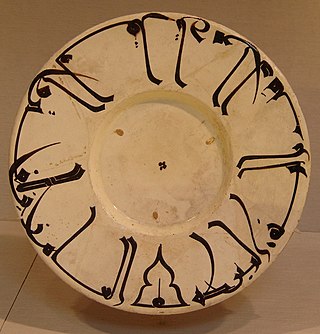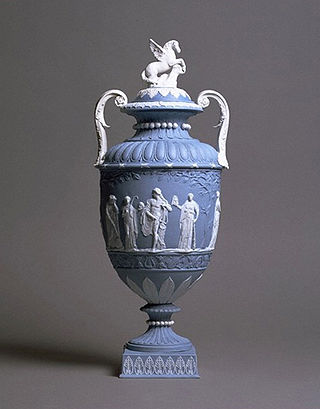
Earthenware is glazed or unglazed nonvitreous pottery that has normally been fired below 1,200 °C (2,190 °F). Basic earthenware, often called terracotta, absorbs liquids such as water. However, earthenware can be made impervious to liquids by coating it with a ceramic glaze, and is used for the great majority of modern domestic earthenware. The main other important types of pottery are porcelain, bone china, and stoneware, all fired at high enough temperatures to vitrify. End applications include tableware, decorative ware such as figurines.

Faience or faïence is the general English language term for fine tin-glazed pottery. The invention of a white pottery glaze suitable for painted decoration, by the addition of an oxide of tin to the slip of a lead glaze, was a major advance in the history of pottery. The invention seems to have been made in Iran or the Middle East before the ninth century. A kiln capable of producing temperatures exceeding 1,000 °C (1,830 °F) was required to achieve this result, the result of millennia of refined pottery-making traditions. The term is now used for a wide variety of pottery from several parts of the world, including many types of European painted wares, often produced as cheaper versions of porcelain styles.

Stoneware is a rather broad term for pottery fired at a relatively high temperature. A modern definition is a vitreous or semi-vitreous ceramic made primarily from stoneware clay or non-refractory fire clay. End applications include tableware, decorative ware such as vases.

Spode is an English brand of pottery and homewares produced by the company of the same name, which is based in Stoke-on-Trent, England. Spode was founded by Josiah Spode (1733–1797) in 1770, and was responsible for perfecting two extremely important techniques that were crucial to the worldwide success of the English pottery industry in the century to follow.

In different periods of time and in different countries, the term majolica has been used for two distinct types of pottery.

Biscuit tins are utilitarian or decorative containers used to package and sell biscuits and some confectionery. Invented by Huntley & Palmers in 1831, they are commonly found in households in Great Britain, Ireland, and Commonwealth countries, but also in continental Europe and French Canada. Popularity in the United States and English Canada spread later in the 20th century. Over 60% of UK households own a biscuit tin.

Biscuit porcelain, bisque porcelain or bisque is unglazed, white porcelain treated as a final product, with a matte appearance and texture to the touch. It has been widely used in European pottery, mainly for sculptural and decorative objects that are not tableware and so do not need a glaze for protection.

William Calder Marshall ARSA was a Scottish sculptor.

Jasperware, or jasper ware, is a type of pottery first developed by Josiah Wedgwood in the 1770s. Usually described as stoneware, it has an unglazed matte "biscuit" finish and is produced in a number of different colours, of which the most common and best known is a pale blue that has become known as Wedgwood Blue. Relief decorations in contrasting colours are characteristic of jasperware, giving a cameo effect. The reliefs are produced in moulds and applied to the ware as sprigs.

Wedgwood is an English fine china, porcelain and luxury accessories manufacturer that was founded on 1 May 1759 by the potter and entrepreneur Josiah Wedgwood and was first incorporated in 1895 as Josiah Wedgwood and Sons Ltd. It was rapidly successful and was soon one of the largest manufacturers of Staffordshire pottery, "a firm that has done more to spread the knowledge and enhance the reputation of British ceramic art than any other manufacturer", exporting across Europe as far as Russia, and to the Americas. It was especially successful at producing fine earthenware and stoneware that were accepted as equivalent in quality to porcelain but were considerably cheaper.

Mintons was a major company in Staffordshire pottery, "Europe's leading ceramic factory during the Victorian era", an independent business from 1793 to 1968. It was a leader in ceramic design, working in a number of different ceramic bodies, decorative techniques, and "a glorious pot-pourri of styles - Rococo shapes with Oriental motifs, Classical shapes with Medieval designs and Art Nouveau borders were among the many wonderful concoctions". As well as pottery vessels and sculptures, the firm was a leading manufacturer of tiles and other architectural ceramics, producing work for both the Houses of Parliament and United States Capitol.
Thomas Battam was a British painter of miniatures. He was born in London. He produced copies in enamels, several of which were exhibited at the Royal Academy, London from 1833 to 1840. Battam later became art director at the Copeland porcelain factory, and was the founder, and president, of the Crystal Palace Art Union. He claimed to be the inventor of Parian Ware, an inexpensive substitute for marble. He died at Notting Hill, London, aged about fifty-four.

Raffaele Monti was an Italian sculptor, author and poet.

John Rogers (1829–1904) was an American sculptor who produced very popular, relatively inexpensive figurines in the latter 19th century.

Pâte-sur-pâte is a French term meaning "paste on paste". It is a method of porcelain decoration in which a relief design is created on an unfired, unglazed body, usually with a coloured body, by applying successive layers of (usually) white porcelain slip with a brush. Once the main shape is built up, it is carved away to give fine detail, before the piece is fired. The work is very painstaking and may take weeks of adding extra layers and allowing them to harden before the next is applied.

Victorian majolica properly refers to two types of majolica made in the second half of the 19th century in Europe and America.
George Halse was a sculptor, novelist, and poet.

China painting, or porcelain painting, is the decoration of glazed porcelain objects such as plates, bowls, vases or statues. The body of the object may be hard-paste porcelain, developed in China in the 7th or 8th century, or soft-paste porcelain, developed in 18th-century Europe. The broader term ceramic painting includes painted decoration on lead-glazed earthenware such as creamware or tin-glazed pottery such as maiolica or faience.

Lead-glazed earthenware is one of the traditional types of earthenware with a ceramic glaze, which coats the ceramic biscuit body and renders it impervious to liquids, as terracotta itself is not. Plain lead glaze is shiny and transparent after firing. Coloured lead glazes are shiny and either translucent or opaque after firing. Three other traditional techniques are tin-glazed, which coats the ware with an opaque white glaze suited for overglaze brush-painted colored enamel designs; salt glaze pottery, also often stoneware; and the feldspathic glazes of Asian porcelain. Modern materials technology has invented new glazes that do not fall into these traditional categories.

Staffordshire figures are a type of popular pottery figurine made in England from the 18th century onward. Many Staffordshire figures made from 1740 to 1900 were produced by small potteries and makers' marks are generally absent. Most Victorian figures were designed to stand on a shelf or mantlepiece and are therefore only modelled and decorated where visible from the front and sides. These are known as 'flatbacks'. They were shaped either by press moulding or slip casting.


















